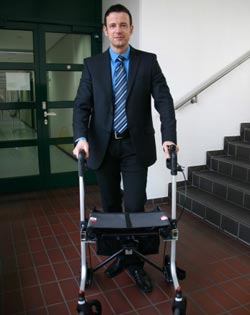A Smart Walker That Looks Ahead

<br>
Airports and shopping centers can pose problems for elderly people, as they might suffer an accident because they have difficulty seeing structural obstacles and signs in the crowded buildings.
However, the new system is designed to not only make senior citizens' everyday life easier but also be used in industrial settings.
At the heart of the c-Walker is a cognitive navigation prosthesis. The walking aid is equipped with various imaging sensors, including the Kinect sensor, which Microsoft developed for the Xbox video game console. The sensor enables the mobile system to monitor its spatial surroundings in real time.
Thanks to its numerous “eyes,” the c-Walker knows not only where it is at any given moment but also where obstacles are located, in which direction people are moving, and even what warning and information signs say. This enables the device to orient users in unstructured environments and guide them to their destinations along optimal routes.
Siemens also plans to use this technology in industrial settings. Because automated production lines are often confusing, people and machines can quickly collide. However, the integration of the new system into portable panel PCs could enable people to interact with machines more safely and comfortably. For example, the devices could warn production workers against entering danger zones and show service technicians the best route through a factory.
The technology helps not only human workers but also their mechanicalcolleagues. It makes robots and ma-chines aware of their surroundings so that they can respond to external influences. For Siemens, this development is an important step toward creating a smart industrial environment in which people and machines can react to one another in order to increase work efficiency.
Siemens is also using the Kinect sensor in a virtual planning system for work processes. In this system, the Kinect technology recognizes an individual's movements and posture and transfers them to an avatar in a virtual environment. In the same way that a player moves intuitively within the scenes of a computer game, technicians can use Kinect to simulate movements in the workplace.
Media Contact
More Information:
http://www.siemens.com/innovationnewsAll latest news from the category: Innovative Products
Newest articles

Bringing bio-inspired robots to life
Nebraska researcher Eric Markvicka gets NSF CAREER Award to pursue manufacture of novel materials for soft robotics and stretchable electronics. Engineers are increasingly eager to develop robots that mimic the…

Bella moths use poison to attract mates
Scientists are closer to finding out how. Pyrrolizidine alkaloids are as bitter and toxic as they are hard to pronounce. They’re produced by several different types of plants and are…

AI tool creates ‘synthetic’ images of cells
…for enhanced microscopy analysis. Observing individual cells through microscopes can reveal a range of important cell biological phenomena that frequently play a role in human diseases, but the process of…





















